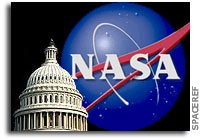GAO – NASA Implementing a Knowledge-Based Acquisition Framework Could Lead to Better Investment Decisions and Project Outcomes

December 2005
NASA Implementing a Knowledge-Based Acquisition Framework Could Lead to Better Investment Decisions and Project Outcomes
Highlights of GAO-06-218, a report to congressional requesters
Why GAO Did This Study
The National Aeronautics and Space Administration (NASA) plans to spend over $100 billion on capabilities and technologies to achieve the initial goals of the President’s 2004 Vision for Space Exploration. In the past, NASA has had difficulty meeting cost, schedule, and performance objectives for some of its projects because it failed to adequately define project requirements and quantify resources. NASA will be further challenged by a constrained federal budget and a shrinking experienced NASA workforce. To help face these challenges and manage projects with greater efficiency and accountability, NASA recently updated its program and project management policy and is developing an agencywide systems engineering policy. GAO has issued a series of reports on the importance of obtaining critical information and knowledge at key junctures in major system acquisitions to help meet cost and schedule objectives. This report (1) evaluates whether NASA’s policy supports a knowledge-based acquisition approach and (2) describes how NASA centers are implementing the agency’s acquisition policies and guidance.
What GAO Recommends
GAO is making several recommendations to help ensure NASA uses a knowledge-based acquisition approach in making informed investment decisions. NASA concurred with GAO’s recommendations.
What GAO Found
While NASA’s revised policy for developing flight systems and ground support projects incorporates some of the best practices used by successful developers, it lacks certain key criteria and major decision reviews that support a knowledge-based acquisition framework. For example, NASA’s policy requires projects to conduct a major decision review before moving from formulation to implementation. Further, before moving from formulation to implementation, projects must validate requirements and develop realistic cost and schedule estimates, human capital plans, a preliminary design, and a technology plan—key elements for matching needs to resources. However, NASA’s policies do not require projects to demonstrate technologies at high levels of maturity before program start. By not establishing a minimum threshold for technology maturity, NASA increases the risk that design changes will be required later in development, when such changes are typically more costly to make. In addition, although NASA’s policy does require project managers to establish a continuum of technical and management reviews, it does not specify what these reviews should be, nor does it require major decision reviews at other key points in a product’s development. Acquiring knowledge at key junctures will become increasingly important as NASA proceeds to implement elements of the Vision. Without a major decision review at key milestones to ensure that the appropriate level of knowledge has been achieved to proceed to the next phase, the risk of cost and schedule overruns, as well as performance shortfalls, increases.
NASA centers have varying approaches for implementing the agency’s policies and guidance. Some centers have established product development criteria that are similar to the criteria used in a knowledge-based acquisition, while other centers have not. As a result, each center reports a different level and type of knowledge about a project at key decision points. Centers also rely on project managers and systems engineers to employ good project management and systems engineering practices. However, given the loss of experienced project managers and the decline of in-house systems engineering and technical capabilities, that reliance could be problematic. These situations make it difficult for decision makers to evaluate projects on the same basis and make sound investment decisions and tradeoffs based on those evaluations. A standardized, knowledge-based approach would prepare NASA to face competing budgetary priorities and better position the agency to make difficult decisions regarding the investment in and termination of projects.
www.gao.gov/cgi-bin/getrpt?GAO-06-218.
To view the full product, including the scope and methodology, click on the link above. For more information, contact Allen Li at (202) 512-4841 or lia@gao.gov.








